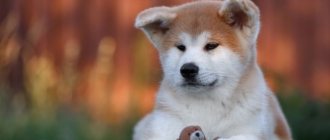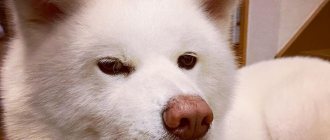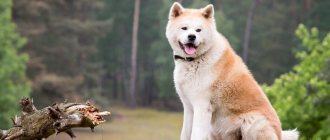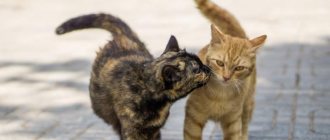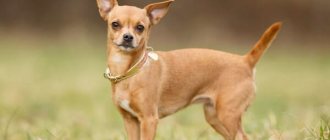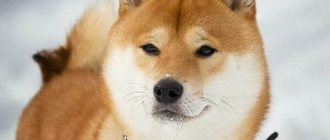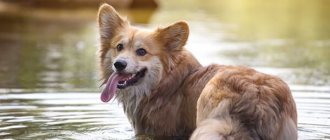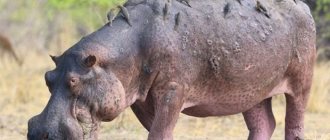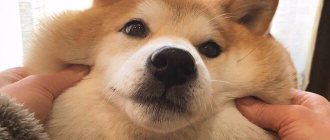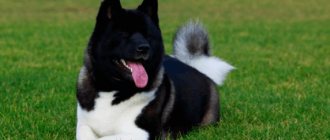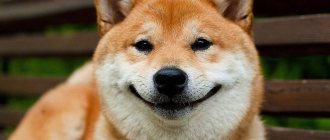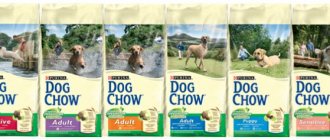Akita Inu and Shiba Inu are popular Japanese dog breeds. And although outwardly they have many similar features, there are many more fundamental differences between them. Differences in the history of origin, size and body features, individual character traits - these are precisely the details that later determined the development of both species.
The Shiba began to be perceived as a companion dog, and the Akita continued to be used exclusively for hunting. What nuances in their appearance and behavior now need to be taken into account when choosing a pet?
Akita Inu
Despite its cute appearance, this breed is different from its four-legged relatives. Among dog trainers and breeders, Akita is perceived almost as a separate brand . Therefore, it is important to familiarize yourself with the main features of these dogs.
Description and photo
Representatives of the Akita Inu breed:
The main highlight of the breed in question is its innate spontaneity and individuality . An animal will be able to demonstrate its natural qualities and high intelligence if the owner begins to raise it from the very first months (and an Akita puppy is considered up to 2-2.5 years inclusive). If you give your dog the attention it deserves, communicate with it often and satisfy its curiosity through games, it is more than possible to get an intelligent and loyal friend as a result.
Having crossed the threshold of adolescence and becoming an adult, the Akita acquires restraint and composure in behavior. From now on she is calm and completely independent. But the silent and confident disposition is just a mask, under which hides a soft, friendly and sensitive creature. Such a pet is very submissive: actita is not at all prone to dirty tricks and willfulness in the house.
We invite you to watch a video about the Akita Inu dog breed:
Exterior
The Akina Inu breed has certain standards . They belong to group 5 “Spitz and primitive type breeds”, section 5 “Asian Spitz and related breeds” and are characterized by a stable exterior:
- a large, but proportional to the body head, similar to an obtuse triangle;
- a wide and flat skull between the ears, with a hollow between the eyes;
- fairly small erect ears, the tip of which should reach the eyes;
- thick and at the same time short neck with powerful muscles;
- developed, wide and deep chest;
- powerful fore and hind limbs, spread to the sides;
- thick coat and soft undercoat, average length over the entire body is 5 cm, but slightly longer on the tail and belly;
- The height at the withers of a male is 66-71 cm, and the size of a female is 61-66 cm.
The appearance of the Akita Inu is quite expressive, because they are included in the list of the most beautiful breeds in the world. According to the requirements, the breed is allowed four color options: red or fawn, with dark tips of hair, brindle and white.
Character
These dogs are very smart and loyal pets and have an excellent memory . From an early age, the Akita is characterized by playfulness and restlessness. Representatives of the breed are fearless and at the same time not aggressive, but in case of danger they will protect their owners to the end. They are independent and curious, so they are easy to train if you manage to find a balance between affection and firmness in training.
Important!
In general, the character of the Akita is a combination of all the positive qualities that are inherent in other breeds. These dogs have practically no negative aspects of their character.
They do not experience unexpected manifestations of aggression or changes in mood. They don’t even bark: only in extreme cases, so teaching this command will be especially difficult.
Shiba Inu
The Akita's sibling may appear to be an exact copy of the above breed . But in fact, completely different standards are applied to such dogs. And the character of these pets is significantly different, which makes them truly unique animals.
Description and photo
Representatives of the Shiba Inu breed:
The Shiba Inu is distinguished by endurance, quick reaction and a developed instinct of self-preservation . Therefore, representatives of this breed are considered excellent watchdogs, but as guards they are noticeably inferior to other pets.
These animals use a whole complex of smell, hearing and vision, and use their innate maneuverability to the maximum to correctly assess the situation. At the same time, Shiba Inu are unpretentious in terms of living conditions and food. They build highly individual, complex and flexible relationships with each family member.
Their character is based on goodwill, which describes the dog as a companion or loyal friend. These dogs love meeting new people . At the same time, they are extremely curious: the more they know about the habits of others, the more comfortable they feel. It is vital for them to feel like they are in a “pack” and understand that their immediate environment is friendly and safe.
We invite you to watch a video about the Shiba Inu dog breed:
Exterior
The Shiba Inu is recognized as a breed by the International Canine Society based on the following standards:
- wide, high-cheekboned head with a pointed (fox-shaped) muzzle;
- almond-shaped, slightly slanted dark eyes;
- small, triangular ears, with a slight forward tilt;
- proportionate, well-built and muscular body;
- thick and short neck with pronounced withers;
- wide back of medium length, with a strong loin and sloping croup;
- straight, erect limbs;
- height 35-42 cm with weight 9-14 kg.
Note!
Despite generally accepted norms, such defects as undershot or undershot are allowed in the breed. But hanging ears and a short, uncurled tail are already considered reasons for disqualification. Of the main colors, the Sibu Inu standard describes several types: red, black and tan and sesame (black and red).
Character
This breed is notable for its very independent character; it is a brave and proud animal, so it is not recommended for novice lovers to have it. Such an active pet must be skillfully guided in the right direction and a clear training strategy is required from the first days - this is the only way to cope with a stubborn pet.
Shiba Inu is capable of demonstrating a whole range of emotions: from joy to deep sadness. These dogs have high intelligence . Even if your four-legged pet does not respond to commands, this means that the dog is simply not in the mood to obey. And when the owner does not have a commanding tone and firmness, then such a reaction can become the main trait in the pet’s character.
Without proper training, a Shiba Inu will turn out to be not a friend, but a burden. You need to be able to negotiate with an animal and make it clear who is in charge in the house.
Upbringing
There will be no harm from an obedience course with a competent instructor, but the main thing in the education process will be:
- establish contact with the dog, hear it and teach it to hear itself;
- socialize your pet from young claws.
Raising a Spitz requires flexibility.
Characteristics of the Shiba Inu breed include an innate increased activity. It needs to be extinguished smoothly, but only excessive activity needs to be extinguished - when the dog is so carried away that it cannot stop itself. Constant tugging can turn an active Shibu into a cowardly, nervous or indifferent one.
Another thing is the satisfaction of activity through games, exercises, and exploration of new territories. It’s useful to stock up on an arsenal of fail-safe “switches” for your dog’s attention.
It is better to start socialization as early as possible. Do not force contacts, but provide the puppy with the opportunity to establish them. Do not interfere with harmless group games, touch little Siba more often, so as not to grow touchy.
While walking, it is useful not to be distracted from the dog. She always watches the owner, waiting for his hint, obvious or hidden.
The flock's territory requires protection . The one who first noticed the threat of violating its boundaries should immediately inform others about it. It is clear that this “first” in the family will be Siba.
You should not scold the dog if its ringing voice woke up the neighbors, even if the alarm turned out to be false (in the human opinion). She, too, was sleeping, and not preparing a prank, she also woke up and saved her flock. A vigilant friend awaits approval. (It is the owner’s task to explain to the neighbors that their house is also in the zone of attention).
The dog will not make noise for a long time - he uses prolonged “barking” only when hunting. It won't hurt to learn the silence command.
What is the difference?
How are dogs different? Akita and Shiba Inu seem to be a single breed to many people . But professionals are well aware of the differences between these dogs. The main differences can be traced not only visually, but also through the behavior of the pets.
The following points are highlighted where the descriptions of animals directly oppose each other:
- Origin story . The Japanese Akita is a native Spitz-type dog that evolved through domestication rather than selective breeding. But the Shiba Inu is the result of artificial breeding, crossing several breeds.
- Size . The Akita is much larger than the Shiba Inu, which should definitely be taken into account when choosing a pet. You should not start the first breed in a small apartment, because a private house is more suitable for it, when, as a second representative, it will get along well in more modest housing.
- Grooming . The Shiba Inu has a less fluffy coat, which makes grooming much easier. If it is recommended to comb it with an ordinary brush once a week, then the Akita Inu needs a special massage comb with sparse teeth and a slicker brush.
- Cleanliness . It is really worth bathing your Akita often - about 2 times every six months due to its thick coat. And a Shiba Inu will only get by with one bath in the same 6 months. They don't like dirt even for a moment of tomfoolery and prefer dry weather for walking.
- Temperament . By nature, Akitas are obedient and receptive dogs that have a sensitive temperament. They become attached to their owner for life. But Shiba Inus show affection through discipline, because in their character there is a significant predominance of calm.
Selection of puppies
You should choose a puppy after assessing the entire litter. Kids should communicate well with each other and approach people without showing cowardice. By temperament, the pet should not be shy or aggressive.
The puppy must be:
- active and playful;
- have clean ears, eyes and tail;
- meet breed standards;
- do not be afraid of people and animals.
Important! Aggressive or cowardly behavior of a puppy will indicate problems in education in the future.
A puppy of Japanese blood should not be cowardly
Choosing a good puppy is half the battle; the main thing is to make every effort to raise a reliable four-legged Akita Inu friend.
What are the similarities between these breeds?
It is also impossible to say that representatives of both breeds are completely different from each other. After all, almost the same requirements are put forward for the appearance of Shiba Inu and Akita in such standards as:
- deep-set and slightly slanted triangular-shaped eyes;
- proportional, muscular build of the body (in males it is more angular and rough, and in females it is refined and light);
- the nose, eyelids and lips are black (although brown is sometimes allowed in white dogs);
- large wedge-shaped head with a short muzzle;
- tail in a ring that lies on the back;
- triangular, wide-set and erect ears;
- powerful paws with tightly pressed toes.
Important!
It is worth noting the repetition of individual character traits. Both the Shiba Inu and the Akita are known for their good nature, friendliness, and “companion” persona. Properly planned training also goes well for both breeds.
Basic characteristics
| Shiba Inu | Akita Inu | |
| Adult dog height | 35-42 cm | 57-71 cm |
| Weight | 8-15 kg | 30-45 kg |
| Characteristic color | Bright red color with white patches in the cheekbones, neck, belly, paws and tail | Red, but there are also black, white, chocolate and brindle dogs |
| Wool length | medium length, thick, hard | |
| Lifespan | 10-15 years on average | |
| average price | 500-3500$ | 320-1650$ |
Which breed is best suited for indoors and outdoors?
The Shiba Inu is a very sociable and active dog . To maintain order in the apartment, it is necessary to provide your pet with regular physical activity. If the animal does not feel tired, it will direct its energy in a different direction - it will decide to try everything. They will begin to chew things, household items, wires and furniture not because of their harmful nature, but because they want to play.
And when keeping this breed in the yard, you should take into account that they do not like leashes and collars. It is undesirable to chain them, despite their tendency to escape, because this can lead to aggression on the part of the animal. In turn, an enclosure or yard is allowed under one condition: a sufficient amount of communication from the owner.
For the option with an apartment, an Akita Inu is much better suited. They also need regular and prolonged exercise to remain calm and obedient. But this breed is much less likely to misbehave. If you give her a decent corner with a sleeping place and toys, then she will spend a significant amount of time there without any problems.
When kept in an enclosure, the requirements for the pet's comfort will be overestimated : it is necessary to have a warm booth, a place for walking and a high fence. Only under such conditions will the Akita feel cared for.
Temperament
In the description of the Shiba Inu breed, according to the standard, attention is necessarily paid to the character of the dog. To achieve this, the Japanese use three concepts: good character, energetic calm and artlessness.
Regarding the first, we can say that the dog is very good-natured. If she respects her master, she is obedient and faithful. At the same time, complete submission is not weakness, but a manifestation of respect. Pets do not like rudeness and harshness, so you need to establish friendly or partnership relations with them. The artlessness of individuals is naturalness, sincerity and simplicity. But at the same time, dogs are proud. To suppress this quality, the owner simply needs to win the dog’s favor and earn the respect.
Energetic calm can be deciphered as courage and audacity in various situations. But a dog will never show these qualities without assessing the situation.
Understanding the situation is a hallmark of the Shiba. She knows exactly when she should stand up for herself, for her owner, she knows exactly when danger threatens. If something threatens her or her loved ones, the faithful protector will show herself.
The above traits appear in an adult dog, and during childhood and adolescence, pets require a very careful approach to education. If you don’t teach a dog to follow house rules, don’t get used to people, and don’t force it to respect its owner in a timely manner, you won’t be able to cope with it in adulthood.
Even if you have already trained your dog, it will remain very self-confident. She can be mischievous and not listen if she thinks she’s right
To teach a dog everything, to help it understand the “dos” and “don’ts,” the owner will need maximum patience, precision, skill, delicacy and caution. A dog of this breed does not want to share anything: its motto is “what’s mine is only mine”
If he makes trouble, he “sucks up”: he rolls around, caresses himself, makes faces, talks like a bird. If the offense is left unattended, he will definitely repeat it. The dog is active and loves to play. If the owner shares her interests, then she will reward him with respect and, accordingly, obedience.
Important! Sibs take 2nd place among dogs in the desire for freedom: escapes, digging, bending fence bars
Opinion of a real breeder about the differences between dogs
In one of the interviews, the owner of the Amanogawa nursery, Maria Spirts, tried to draw a line between such seemingly similar breeds. According to the breeder, Akita Inu and Shiba Inu are dogs that have very high intelligence and are ready to defend their owner. But if the Shiba Inu limits itself to “a menacing growl and bark, with the help of which it will keep the stranger away from itself,” then in the case of the Akita, “a fight is guaranteed, because the dog will prove its superiority to the last.”
According to Maria, among Akita Inu dogs there are many dominant ones. While the Shiba Inu thinks and acts more rationally, is patient and ready to compromise in case of danger.
Reviews
Maria, Moscow: “I’ve been training Akitas for 7 years. And for me there is no better dog in the world. I can talk about them for hours. Akita is proud and independent, but also an excellent companion. I wouldn’t trade such a dog for any other breed.”
Elena, Yaroslavl: “When choosing a puppy, we settled on a Shiba Inu and have never regretted it. The dog got along well with children and our other animals. Owners of this breed are definitely the happiest owners.”
Kirill, 29 years old, Novosibirsk: “Initially I wanted to buy an Akita Inu. But after getting to know the breed in detail, I decided that for my conditions the Shiba was a more suitable option. The dog is willful, but proper training and patience make it an ideal pet.”
Attitude towards children and pets
An Akita will be very tolerant of children if they have lived together since childhood. With the right approach, purebred dogs will become faithful companions for children over 8 years old . When interacting with a younger child, this breed does not perceive sudden movements and noise well, so they can often show aggression and self-defense in response to unexpected movements.
Important!
Dogs have a good memory, which is why they remember the slightest offense towards a child (pushes, tugging, blows). The Akita Inu is even more hostile towards other dogs: it always tries to dominate the dogs, which is why conflict situations arise.
Shiba Inu will be more subtle psychologists, capable of perfectly studying the characters and habits of the surrounding household members. Despite their blind love for their owner, pets are wary of physical contact (stroking, attempts to put on a collar, etc.), responding with an indignant howl to any attempts. To avoid such a reaction, your four-legged friend needs to be taught affection from an early age.
For children they can become nannies and companions. Dogs are hostile towards strangers , although they will not show aggression without reason. But they find it difficult to get along with other animals and often show jealousy (especially with cats).
Who is more picky about feeding?
The main feature of the Akita Inu is its high tendency to food allergies. In Japan, the breed ate dietary food: fish, rice, vegetables, seaweed salads and seafood. Therefore, the diet should be light and low-calorie, because excessive amounts of fat and grains lead to allergies.
The most common cause of allergies is chicken. Dogs are genetically predisposed to eat fish, and large amounts of meat (especially chicken) in the diet can cause rashes and eczema. The dog may even lose its undercoat. Ready-made dry and wet mixtures for Akita Inu can also be a simple solution to the problem. In addition, the animal should always have access to fresh water.
The Shiba Inu's native food is seafood . Therefore, it is recommended to select individual ready-made food that includes a specific type of protein, but not beef or soy. Natural nutrition may include varieties of fish with healthy fats - salmon or tuna, meat products - duck or lamb.
It is better to make the basis of the diet with ready-made fish food for puppies, low-fat fermented milk products, raw and boiled vegetables, fruits (zucchini, pumpkin, apples) and rice. At the same time, it is necessary to give the puppy specialized supplements rich in calcium for the proper formation of the skeleton.
Comparison by other criteria
If we evaluate the pet’s attachment to its owner, then the Akita is more emotionally dependent on its owner. It is difficult to discern love in an adult dog, but they still remain very loyal dogs. But the Shiba Inu is not ready to share its love with everyone: it will only maintain partnerships with family members, but it will love its owner immensely and obey more.
Definitely, the Akita Inu is the more popular breed because of the story of Hachiko . Pet-class puppies cost approximately 20 thousand rubles. (50-80 thousand rubles for purebreds). But the Shiba Inu costs 50% less - about 13 thousand rubles. (or 25-50 thousand rubles for a pet with a good pedigree). It cannot be said that nurseries of the mentioned breeds are a rarity for the country. But in Russia there really aren’t that many of them: Indigo-Smile, Mai Hoshi, Milana Light, Zoomir and Hangy’s Anet.
Who is better to choose
The strong similarity of the two breeds often gives rise to the question of who is better to have, an Akita or a Shiba. When choosing, you need to focus on many factors: place of residence, free time, physical activity, training experience, presence of animals and children.
Akita Inu will be an ideal choice for people:
- living in a private house;
- having no animals or children;
- able to devote a lot of time to the pet;
- looking for a dog to be a guardian and a hunting assistant.
In turn, the Shiba Inu is perfect for those who:
- lives in an apartment;
- physically active (this will be needed during walks);
- able to show patience in training or already has experience;
- contains other animals;
- raises children.
Expert opinion
Anna Abramenko
An avid dog lover. Experience in veterinary medicine since 2009.
Ask a Question
This comparison is conditional. Both breeds are active, friendly, and strongly attached to their owner. A dog's behavior depends, first of all, on the quality of its upbringing. Even the most restless puppy can be turned into an intelligent and patient animal with the help of training.
Future owners should approach the choice of a puppy responsibly. Under no circumstances should it be presented as a gift. Each person must make his own decision about the degree of responsibility he is willing to assume.
